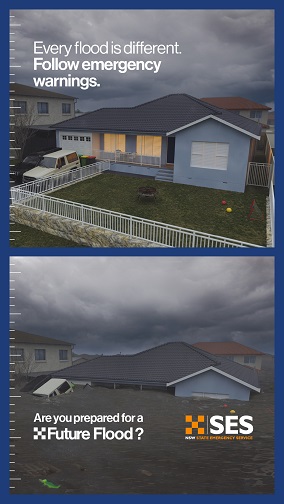Be Aware
Know the official Bureau of Meteorology flood warning products
- Flood Watch is issued by the Bureau of Meteorology and provides a 'heads up' that flooding is likely.
- Flood Warning is issued by the Bureau of Meteorology and warns a community of flooding at a predicted height, time and location.
Know the official NSW SES flood warning products
The NSW SES issues community specific warnings once a Flood Watch or Flood Warning product is published by the Australian Bureau of Meteorology. NSW SES flood warnings include:
- Details of the predicted flood height, based on Bureau of Meteorology forecasts
- Estimated time and location of predicted flooding, based on Bureau of Meteorology forecasts
- Expected flood risks, impacts and consequences to the community
- The safest actions for people to take to protect themselves, their family, and their property
Leading up to and during a flood, NSW SES issues the following official warnings:
- Stay Informed - Advice warns a community that flooding has started and provides information on likely flood consequences and what actions people should take to protect themselves and their property.
- Do Not Enter Floodwater - Watch and Act warns that a flood situation is becoming more serious and instructs people not to drive, walk, ride, play or swim in floodwater - it is dangerous, toxic, and may void car insurance.
- Prepare to Isolate - Watch and Act warns people that they are likely to become isolated by rising floodwater and that they should stock up on essential items before roads and evacuation routes close.
- Prepare to Evacuate - Watch and Act warns people that they need to prepare to evacuate so they can act quickly if evacuation is necessary. Flooding is likely to cut evacuation routes and potentially inundate property. This warning advises the safest actions for the community to take in a flood emergency.
- Evacuate Now/Before - Emergency Warning warns that lives and properties are at-risk due to dangerous flooding, and that people need to evacuate an area immediately or when instructed by emergency services. Flooding is likely to cut evacuation routes and inundate property. This warning advises people what to do if instructed to evacuate and where to go.
- Shelter Now - Emergency Warning warns people that it is too late to leave a flooded area safely as evacuation routes are likely to be cut off. People should instead seek shelter inside a sturdy raised structure or building that can be safely accessed and call for help if needed.
- Move to Higher Ground - Emergency Warning warns people that rising floodwater is making it unsafe to evacuate an area. People in the impacted area should move away from floodwater, as high above ground as possible and call for help if needed.
- Avoid the Area - Watch and Act warns people that a specific area is unsafe due to dangerous flooding and should be avoided until further notice.
- Reduced Threat: Return with Caution - Advice advises evacuated communities that they should take care when returning to flood impacted areas as damage can be widespread and dangerous. People must be cautious and ensure their property is safe before re-entering.
- Monitor Conditions - Advice advises people that the flood threat has eased but they must remain vigilant and consider potential hazards like damage to roads, bridges and infrastructure.
View All Current NSW SES Warnings
Monitor your flood situation
You may not always receive an official warning before floods begin to impact you, therefore it is important to be aware of the flood situation in your local area.
Monitor the local situation by personally witnessing the height and rate at which floodwaters are rising; maintain contact with other people in your local community and listen to your local radio stations to receive and share updates on the flood situation.
Monitor the likelihood of flash flooding
Severe Weather Warnings and Severe Thunderstorm Warnings issued by the Bureau of Meteorology warn of the possibility of flash flooding.
When flash flooding is likely, it is best to evacuate low-lying homes and businesses well before flash flooding begins, but only if it is safe to do so. If you are trapped by rising floodwater, seek refuge in the highest part of a sturdy building. Stay there and call '000' (triple zero) if you need rescue.
Warning Products
Severe Thunderstorm Warnings
The Bureau of Meteorology issues Severe Thunderstorm Warnings whenever severe thunderstorms are occurring in an area or are expected to develop or move into the area during the next few hours. The warnings describe the area under threat and the particular hazards likely to be associated with the thunderstorms including flash flooding.
Severe Weather Warnings
The Bureau of Meteorology issues Severe Weather Warnings whenever severe weather is occurring in an area or is expected to develop or move into an area. The warnings describe the area under threat and the expected hazards. Warnings are issued with varying lead-times, depending on the weather situation, and range from just an hour or two up to about 24 hours.
Severe Weather Warnings are issued for:
- Sustained winds of gale force (63 km/h) or more
- Wind gusts of 90 km/h or more
- Very heavy rain that may lead to flash flooding
- Abnormally high tides (or storm tides) expected to exceed highest astronomical tide
- Unusually large surf waves expected to cause dangerous conditions on the coast
- Widespread blizzards in Alpine areas
Flood Watch
A Flood Watch is issued by the Bureau of Meteorology if flood producing rain is expected to happen in the near future and flooding is expected to be above Minor level. A Flood Watch covers a river basin or catchment. The general weather forecasts can also refer to flood producing rain. You should be prepared to act should flooding occur.
Flood Warning
A Flood Warning is issued by the Bureau of Meteorology when flooding is expected to occur or is happening. Flood Warnings provide a predicted flood level and time at which a river will reach that level. Flood Warnings are issued in relation to flood gauges which are situated at a certain point on a river. Flood Warnings may contain observed, peak or predicted river heights.
NSW SES Warning Products
NSW SES Warning Products outlined above provide information on likely flood consequences and what actions are required to protect yourself and your property.
Interpreting Flood Levels
Minor flooding
Flooding which causes inconvenience such as closing of minor roads and the submergence of low-level bridges. The lower limit of this class of flooding is the initial flood level at which landholders and/or townspeople begin to be affected in a significant manner that requires the issuing of a public flood warning by the Australian Government Bureau of Meteorology.
Moderate flooding
Flooding which inundates low-lying areas, requiring removal of stock and/or evacuation of some houses. Main traffic routes may be flooded.
Major flooding
Flooding which causes inundation of extensive rural areas, with properties, villages and towns isolated and/or appreciable urban areas flooded.
Interpreting river heights
Flood Warnings may contain observed, peak or predicted river heights, these are often referenced from a flood gauge at a certain point along a river.
Predicted River Height
The height (in metres) to which the river is predicted to rise at the river gauge referred to in the warning. The actual depth of flood water will vary across the floodplain. Knowledge of past flood events, as well as estimates of flood levels from flood studies, are used by local Councils, emergency services and landowners to determine which areas are likely to be flooded from the predicted river height. The accuracy of this prediction will depend on a number of factors, including the type of flood forecasting model and its input data. Predicted river heights are subject to forecasting error and are regularly updated as more information becomes available.
Observed River Height
Depth of water (in metres) at a river height measuring gauge located along the river. In most cases, a zero reading is the lowest water level that is reached during dry conditions. In many tidal areas, as well as a few inland areas, river levels are expressed in metres above mean sea level or Australian Height Datum (AHD).
Peak River Height
Highest river height (in metres) observed during a flood event at the specified site on the river.
Dam Failure Alerts
Dam failure alerts
In New South Wales dam safety is monitored in most circumstances by the owner of the dam. During heavy rainfall or a flooding upstream, high volumes of water can create additional pressure on the dam wall and may affect its structural integrity.
In some instances water can be released to relieve this pressure. Prescribed dams often have early warning systems for communities that lie downstream of the dam and close to the dam.
Some of these alert systems are below:
White Alert
A White Alert can advise if a structural defect has been detected (e.g. crack, piping) or if there is a heavy rainfall event.
Amber Alert
An Amber Alert often triggers a Prepare to Evacuate - Watch and Act level warning and advises that dam failure could be possible if storage continues rising or a structural defect is not fixed.
Red Alert
A Red Alert often triggers an Evacuate Now - Emergency Warning and advises that dam failure is imminent or has occurred.
Look out for each other when flooding is imminent



